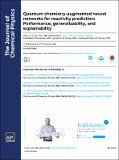| dc.contributor.author | Stuyver, Thijs | |
| dc.contributor.author | Coley, Connor W | |
| dc.date.accessioned | 2022-09-19T12:00:09Z | |
| dc.date.available | 2022-09-19T12:00:09Z | |
| dc.date.issued | 2022 | |
| dc.identifier.uri | https://hdl.handle.net/1721.1/145469 | |
| dc.description.abstract | <jats:p> There is a perceived dichotomy between structure-based and descriptor-based molecular representations used for predictive chemistry tasks. Here, we study the performance, generalizability, and explainability of the quantum mechanics-augmented graph neural network (ml-QM-GNN) architecture as applied to the prediction of regioselectivity (classification) and of activation energies (regression). In our hybrid QM-augmented model architecture, structure-based representations are first used to predict a set of atom- and bond-level reactivity descriptors derived from density functional theory calculations. These estimated reactivity descriptors are combined with the original structure-based representation to make the final reactivity prediction. We demonstrate that our model architecture leads to significant improvements over structure-based GNNs in not only overall accuracy but also in generalization to unseen compounds. Even when provided training sets of only a couple hundred labeled data points, the ml-QM-GNN outperforms other state-of-the-art structure-based architectures that have been applied to these tasks as well as descriptor-based (linear) regressions. As a primary contribution of this work, we demonstrate a bridge between data-driven predictions and conceptual frameworks commonly used to gain qualitative insights into reactivity phenomena, taking advantage of the fact that our models are grounded in (but not restricted to) QM descriptors. This effort results in a productive synergy between theory and data science, wherein QM-augmented models provide a data-driven confirmation of previous qualitative analyses, and these analyses in turn facilitate insights into the decision-making process occurring within ml-QM-GNNs. </jats:p> | en_US |
| dc.language.iso | en | |
| dc.publisher | AIP Publishing | en_US |
| dc.relation.isversionof | 10.1063/5.0079574 | en_US |
| dc.rights | Creative Commons Attribution 4.0 International license | en_US |
| dc.rights.uri | https://creativecommons.org/licenses/by/4.0/ | en_US |
| dc.source | American Institute of Physics (AIP) | en_US |
| dc.title | Quantum chemistry-augmented neural networks for reactivity prediction: Performance, generalizability, and explainability | en_US |
| dc.type | Article | en_US |
| dc.identifier.citation | Stuyver, Thijs and Coley, Connor W. 2022. "Quantum chemistry-augmented neural networks for reactivity prediction: Performance, generalizability, and explainability." The Journal of Chemical Physics, 156 (8). | |
| dc.contributor.department | Massachusetts Institute of Technology. Department of Mechanical Engineering | en_US |
| dc.relation.journal | The Journal of Chemical Physics | en_US |
| dc.eprint.version | Final published version | en_US |
| dc.type.uri | http://purl.org/eprint/type/JournalArticle | en_US |
| eprint.status | http://purl.org/eprint/status/PeerReviewed | en_US |
| dc.date.updated | 2022-09-19T11:55:58Z | |
| dspace.orderedauthors | Stuyver, T; Coley, CW | en_US |
| dspace.date.submission | 2022-09-19T11:56:04Z | |
| mit.journal.volume | 156 | en_US |
| mit.journal.issue | 8 | en_US |
| mit.license | PUBLISHER_CC | |
| mit.metadata.status | Authority Work and Publication Information Needed | en_US |
